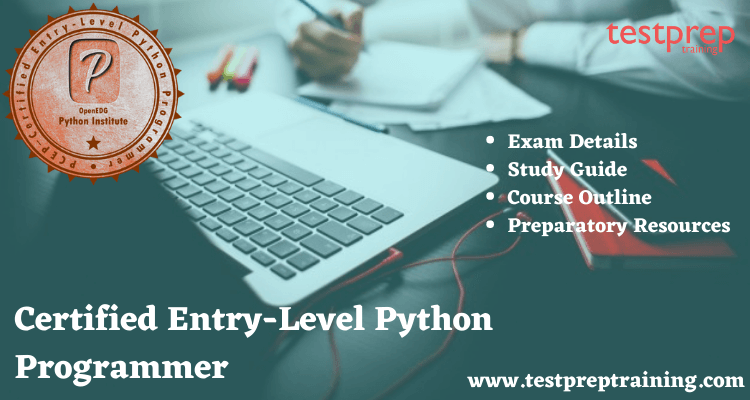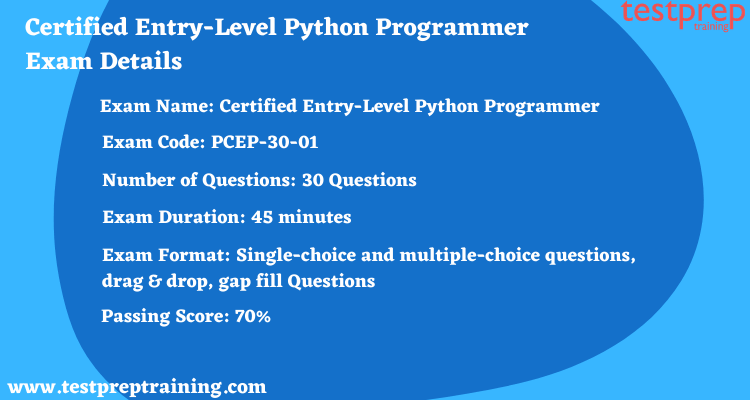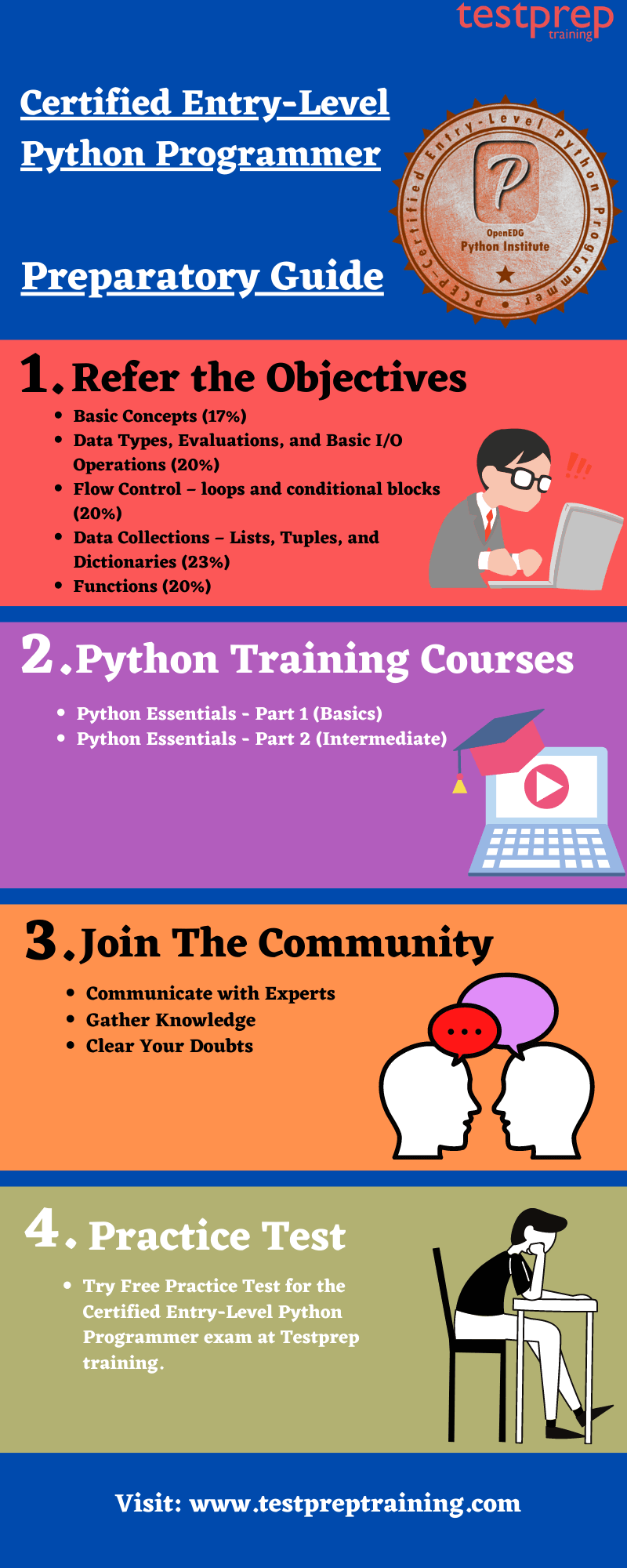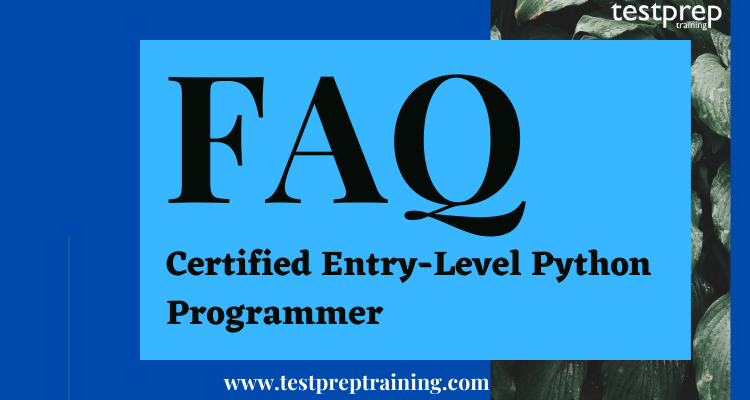Certified Entry-Level Python Programmer

The Certified Entry-Level Python Programmer Certification (PCEP) is a great place to start when getting Python certified. The Python Institute provides multiple certification exams for Python ranging from entry-level to a professional level. PCEP – Certified Entry-Level Python Programmer certification is a professional credential that measures your ability to accomplish coding tasks related to the essentials of programming in the Python language. A test candidate should demonstrate sufficient knowledge of the universal concepts of computer programming, the syntax, and semantics of the Python language as well as the skills in resolving typical implementation challenges with the help of the Python Standard Library.
About Certified Entry-Level Python Programmer Exam
PCEP – Certified Entry-Level Python Programmer certification shows that the individual is familiar with universal computer programming concepts like data types, containers, functions, conditions, loops, as well as Python programming language syntax, semantics, and the runtime environment.
Becoming PCEP certified ensures that the individual is acquainted with the most essential means provided by Python 3 to enable them to start their own studies at an intermediate level and to continue their professional development.
Who can take this exam?
Here are some important prerequisites to attend this course:
- The person should have ample knowledge of the fundamental concepts of computer programming
- Should able to know the basic syntax and semantics of the Python programming language
- The person is also able to resolve typical implementation challenges using the Python Standard Library.
Exam Details: Certified Entry-Level Python Programmer

The Certified Entry-Level Python Programmer exam is an entry-level exam that has a code PCEP-30-01. Further, the exam consists of 30 questions which are in the form of Single-choice and multiple-choice questions, drag & drop, gap fill questions. The candidate needs to score 70% marks in order to clear the Certified Entry-Level Python Programmer exam. Also, the candidate will be given 45 minutes (exam) + approx. 5 minutes (Non-Disclosure Agreement/Tutorial) to complete the exam and the exam is available in the English language. The exam fee is USD 59.
For more details about the exam visit Certified Entry-Level Python Programmer FAQ
The candidate should visit the official page of Python terms and conditions, privacy policies, etc. The Terms and conditions for Python include the Education, Definitions and Interpretations, Basis of Orders, Registration and Dates, download and access to online training, Price and payment, prerequisites, etc.
Exam Course Outline
PCEP – Certified Entry-Level Python Programmer certification is an interim step to the PCAP – Certified Associate in Python Programming certification and the starting point to launch a career in software development, Python programming, and related technologies. Becoming PCEP certified will help you stand out from other candidates and get your foot in the door. The learning objectives for the Certified Entry-Level Python Programmer exam are:
Basic Concepts (17%)
- fundamental concepts: interpreting and the interpreter, compilation and the compiler, language elements, lexis, syntax and semantics, Python keywords, instructions, indenting
- literals: Boolean, integer, floating-point numbers, scientific notation, strings
- comments
- the print() function
- the input() function
- numeral systems (binary, octal, decimal, hexadecimal)
- numeric operators: ** * / % // + –
- string operators: * +
- assignments and shortcut operators
Data Types, Evaluations, and Basic I/O Operations (20%)
- operators: unary and binary, priorities and binding
- bitwise operators: ~ & ^ | << >>
- Boolean operators: not and or
- Boolean expressions
- relational operators ( == != > >= < <= ), building complex Boolean expressions
- accuracy of floating-point numbers
- basic input and output operations using the input(), print(), int(), float(), str(), len() functions
- formatting print() output with end= and sep= arguments
- type casting
- basic calculations
- simple strings: constructing, assigning, indexing, immutability
Flow Control – loops and conditional blocks (20%)
- conditional statements: if, if-else, if-elif, if-elif-else
- multiple conditional statements
- the pass instruction
- building loops: while, for, range(), in
- iterating through sequences
- expanding loops: while-else, for-else
- nesting loops and conditional statements
- controlling loop execution: break, continue
Data Collections – Lists, Tuples, and Dictionaries (23%)
- simple lists: constructing vectors, indexing and slicing, the len() function
- lists in detail: indexing, slicing, basic methods (append(), insert(), index()) and functions (len(), sorted(), etc.), del instruction, iterating lists with the for loop, initializing, in and not in operators, list comprehension, copying and cloning
- lists in lists: matrices and cubes
- tuples: indexing, slicing, building, immutability
- tuples vs. lists: similarities and differences, lists inside tuples and tuples inside lists
- dictionaries: building, indexing, adding and removing keys, iterating through dictionaries as well as their keys and values, checking key existence, keys(), items() and values() methods
- strings in detail: escaping using the \ character, quotes and apostrophes inside strings, multiline strings, basic string functions.
Functions (20%)
- defining and invoking your own functions and generators
- return and yield keywords, returning results,
- the None keyword,
- recursion
- parameters vs. arguments,
- positional keyword and mixed argument passing,
- default parameter values
- converting generator objects into lists using the list() function
- name scopes, name hiding (shadowing), the global keyword
Preparatory Guide for Certified Entry-Level Python Programmer Exam

The development steps which are necessary in order to successfully pass the Certified Entry-Level Python Programmer exam are:
Python Institute Official Website
Touring the Python Institute official website is an important step while preparing for the exam like Certified Entry-Level Python Programmer. Also, the official website provides a lot of essential information and sources which is very helpful in preparing for the exam. Further, resources such as study guides, courses, sample papers, training programs, whitepapers, documentation, faqs, etc. The candidate can find all such important things on the official page.
Revise the Required skills
The candidate should understand and revise all the basic skills and knowledge that the exam Certified Entry-Level Python Programmer required. So, here is the list that you should understand:
- Basics of Python
- Boolean values
- Compilation vs. interpretation
- Concept of variables and variable naming conventions
- Defining and using functions
- Fundamentals of computer programming
- Fundamentals of OOP and how it is used in the Python programming language
- Generators and closures
- Inputting and converting of data
- Logical vs. bitwise operations
- Looping and control statements
- Means used by Python developers for processing files
- Name scope issues
- New data aggregates: tuples and dictionaries
- Primary kinds of data and numerical operators
- Python modules
- Python’s implementation of inheritance
- Rules governing the building of expressions
- Slicing/Working with multi-dimensional arrays
- Strings, lists, and other Python data structures
- The assignment operator
- The concept of exceptions and implementation.
Python Institute Training Courses
The candidate can also opt for the Python Institute training programs. The Python Institute offers training programs on every exam. The training programs for a particular exam contain all information on the exam such as description, intended audience, delivery method, duration, etc. The candidate should join a training program to gain knowledge and skills for Certified Entry-Level Python Programmer. With the training courses with Python Institute, the candidate will receive in-person instruction from experts in one of their state-of-the-art training facilities. You can opt for the following training programs:
Python Essentials – Part 1 (Basics)
Python Essentials – Part 2 (Intermediate)
Join a Study Group
Joining a group study or an online community will also be useful for the candidate. It will help them to do more hard work. Also, studying in the group will help them to stay connected with the other people who are on the same pathway as them. Also, the discussion of such study groups will benefit the students in their exams.
Evaluate yourself with Practice Test
Practice tests are the one which ensures the candidate about their preparation. The practice test will help the candidates to acknowledge their weak areas so that they can work on them. There are many practice tests available on the internet nowadays, so the candidate can choose which they want. Also, SAP offers its own practice test. The candidate can start Preparing for Certified Entry-Level Python Programmer Now!


